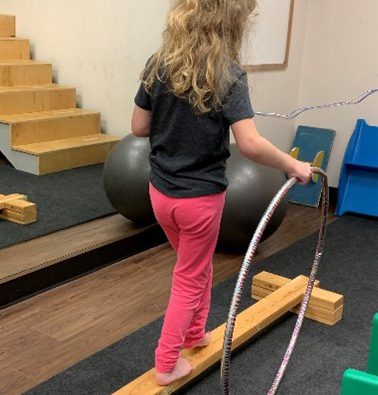Written By: Stephanie Johnson, PT
 Toe walking is commonly accepted as typical behavior for a toddler who is learning to walk. During the first couple of years, a child will explore different walking patterns as their body adapts to an upright posture. The good news is most children will outgrow this exploratory gait pattern on their own in the accepted time frame of 2 to 3 years old. It is when toe walking persists that parents, medical professionals, and researchers begin to take a closer look.
Toe walking is commonly accepted as typical behavior for a toddler who is learning to walk. During the first couple of years, a child will explore different walking patterns as their body adapts to an upright posture. The good news is most children will outgrow this exploratory gait pattern on their own in the accepted time frame of 2 to 3 years old. It is when toe walking persists that parents, medical professionals, and researchers begin to take a closer look.
As a clinician, treating childhood toe-walking was a source of frustration and angst. Tears and tantrums would sometimes follow – not to mention how the parents and child I was treating would react. Not every idiopathic toe walking diagnosis is actually “unknown”. Once I made that connection in my evaluation of this diagnosis, treatment protocols became easier, outcomes improved and goals were more readily met.
 Effectively addressing the pediatric toe walking gait pattern can be a challenging task for many pediatric therapists. Several underlying causes can contribute to this abnormal gait pattern which makes a differential evaluation protocol paramount in driving effective treatment techniques for a beneficial outcome. If a child is given an orthopedic or neurological diagnosis, it guides the treatment parameters, but what about the children who arrive at your practice who have not been given a clear diagnosis?
Effectively addressing the pediatric toe walking gait pattern can be a challenging task for many pediatric therapists. Several underlying causes can contribute to this abnormal gait pattern which makes a differential evaluation protocol paramount in driving effective treatment techniques for a beneficial outcome. If a child is given an orthopedic or neurological diagnosis, it guides the treatment parameters, but what about the children who arrive at your practice who have not been given a clear diagnosis?
My upcoming webinar Differential Diagnosis of the Toe Walking Gait Pattern on April 19th explores these underlying causes and identifies a systematic approach to determine the course of action to drive treatment. My goal is to help you improve functional outcomes in your pediatric practice through the implementation of specific evaluation and treatment techniques for each underlying cause. Not every child toe walks for the same reason, so it stands to reason we need to create a plan of care specific to each one. Join me on April 19th to learn these differences so you, too, can assess and treat toe walking with confidence.
Explore continuing education courses from Stephanie below:
Differential Diagnosis of the Toe Walking Gait Pattern
Infant Positioning Strategies Progressing Development while Promoting Safe Sleep
Visit summit-education.com for more information.
References:
Karen Davies, Alec Black, Michael Hunt, Lisa Holsti, Long-term gait outcomes following conservative management of idiopathic toe walking, Gait & Posture, Volume 62, 2018, Pages 214-219
